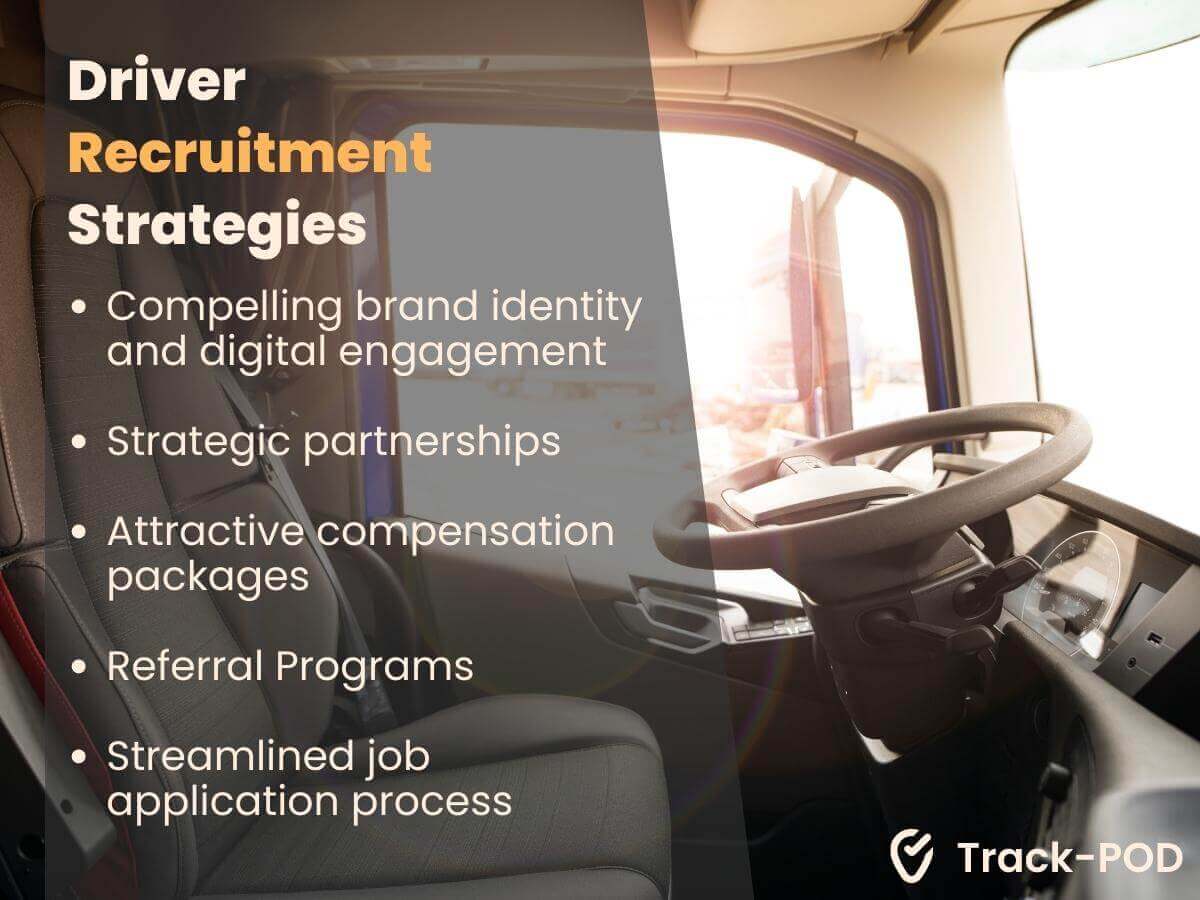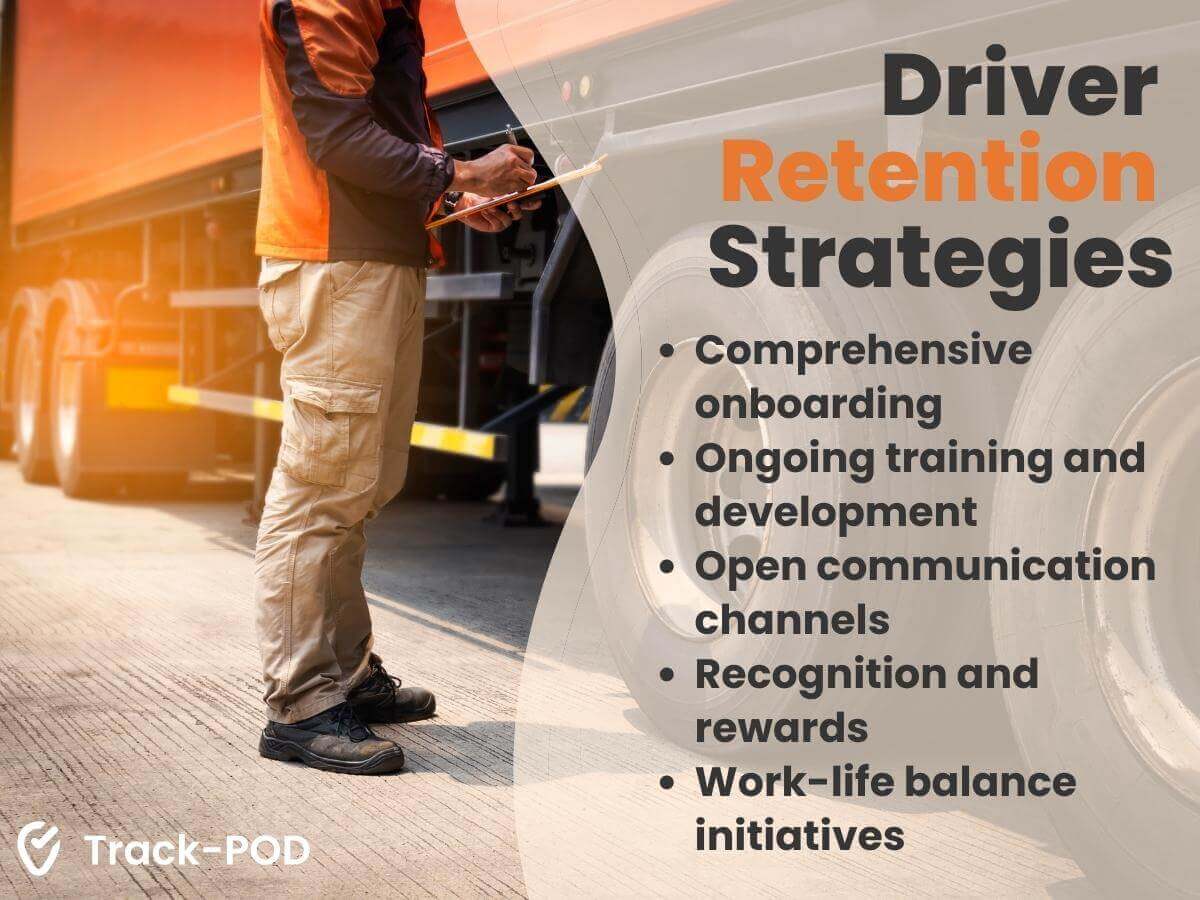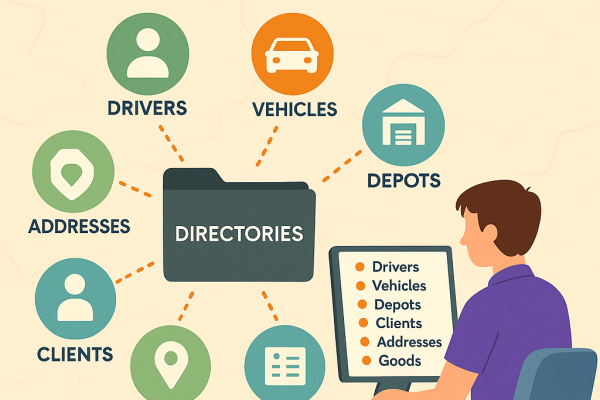Driver Retention: 12 Effective Strategies to Hire and Retain Delivery Drivers

by
Alina Kostukova
August 11, 2023
As today's supply chain relies heavily on the seamless movement of goods, the role of truck drivers has never been more crucial.
These modern-day road warriors keep our economy moving, bridging the gap between suppliers, retailers, and customers across vast distances.
However, the journey isn't always smooth. The trucking industry is currently navigating a challenging terrain: recruiting and retaining these essential drivers.
Driver turnover rates in logistics are increasing yearly, so businesses seek ways to improve driver retention and create better work conditions.
Join us as we delve into the primary concerns regarding the recruitment and retention of delivery drivers, and discuss successful tactics to enhance both aspects.
Driver recruitment: issues and challenges
The recruitment of drivers is at a crucial point in modern transportation, where demand and opportunity come together.
Yet, the road to finding and retaining qualified truck drivers is paved with unique challenges.

Let's take a closer look at the key recruitment challenges faced by the supply chain sector:
-
Intense job market competition for personnel: Drivers are in high demand across various sectors, leading to fierce competition for their attention. Logistics companies need to stand out and showcase their unique offerings to attract prospective drivers and couriers.
-
High turnover rates: Retaining drivers can be as challenging as recruiting them. Factors such as job dissatisfaction, inadequate compensation, and lack of career perspectives can contribute to high driver turnover rates.
-
Aging workforce: A significant portion of the existing driver workforce is approaching retirement age. The average age of over-the-road truck drivers is 46, according to the American Trucking Association. This is older than the average age of all full-time jobs. Replenishing this aging workforce with a new generation of drivers is crucial to ensure the industry's sustainability.
-
Technological shift: The integration of new technology in logistics is transforming the industry. Some IoT technologies, such as advanced sensors and GPS tracking systems, make it easier for logistics drivers to do their jobs. However, other technologies, such as AVs and delivery drones, are eliminating the need for human labor altogether. Ensuring that drivers are adequately trained to handle and benefit from the new technologies is yet another challenge for the logistics industry.
What does truck driver retention mean?
Driver retention is the foundation of a strong and successful logistics business.
It refers to the fact of not only hiring qualified personnel but also ensuring their long-term loyalty and satisfaction to the company over the long haul.
Driver retention is a strategic approach recognizing drivers as more than just employees but as valued partners in the supply chain journey.
In a world where the demand for reliable trucking services continues to surge, retaining drivers takes on paramount importance. It's not just about filling seats; it's about building enduring relationships based on respect, support, and mutual growth.
A low driver retention rate can be harmful to the business, leading to increased operational costs and decreased efficiency.
Driver retention offers a multitude of benefits that extend beyond financial gains.
Drivers who feel valued and appreciated are more likely to go the extra mile – quite literally.
Their familiarity with routes and procedures adds extra efficiency to operations, elevating the fleet's overall performance.
At its heart, improving employee retention is about creating a good work-life balance and an environment where drivers' concerns are addressed and their achievements are celebrated.
Best practices for recruiting and retaining delivery drivers
Maintaining and expanding your business depends on your ability to attract and retain talented drivers.
As we discussed the main driver recruitment challenges, let's explore practical solutions and approaches to attract and retain top-notch truck drivers.
Truck driver recruitment strategies
Here are six strategic approaches to hiring delivery drivers that will help your business grow and be more successful in the future.

1. Compelling brand identity and digital engagement
Craft a robust brand image that resonates with potential drivers.
Leverage social media platforms to showcase your company culture and driver-centric approach. Use professional social media management software to better plan and organize any campaigns.
Highlight your company's values, commitment to driver safety, and career growth opportunities. However, make sure to not post too much on social media and to research the best time to post stories or posts to reach your target audience effectively.
2. Strategic partnerships
Your company can collaborate with driving schools and vocational institutions to establish a talent pipeline.
Vocational skills are in high demand today, so trucking companies often recruit freshly-graduated talents.
Offer internships, training programs, and mentorship opportunities to prepare new drivers according to logistics industry standards.
3. Attractive compensation packages
Build competitive compensation packages that reflect the value of a driver's contribution.
After all, competitive salary is one of the main retention drivers.
You can include a transparent pay structure, performance-based bonuses, and other comprehensive benefits to make your offer stand out.
4. Referral programs
By implementing referral programs, trucking companies can tap into the power of their existing driver workforce to attract new talent.
Current delivery drivers can become your brand's ambassadors and actively promote the company to potential candidates.
Companies can offer bonuses or rewards to drivers who successfully bring in new hires to incentivize referrals.
5. Streamlined job application process
Simplify the courier recruitment process by providing an intuitive and clear online application system.
Minimize paperwork, expedite background checks, and facilitate timely communication to ensure a smooth and efficient experience for applicants.
6. Flexibility
Working with contract drivers as part of a recruitment strategy introduces a flexible approach to addressing the challenges of driver shortages.
Contract or freelance drivers are individuals or small businesses that provide their services on a contractual basis rather than being traditional full-time employees.
Contract drivers may help manage personnel turnover and changing customer demands.
By carefully managing contracts, compliance, and communication, businesses can harness the benefits of this approach while maintaining quality service.
Delivery driver retention strategies
One step is to hire enough experienced drivers. Another step is to keep drivers working for your business.
Here are some surefire strategies to improve the working conditions of truck drivers and minimize employee turnover.

1. Comprehensive onboarding
Develop a comprehensive onboarding program that helps new drivers acclimate quickly.
Offer orientation, training, and mentorship to ensure they feel confident and connected from day one.
“You could get started with Track-POD within a day. The driver’s app is just as self-explanatory as the dashboard.”
Open and clear communication with the newly onboarded couriers is one of the drivers of employee retention.
2. Ongoing training and development
Set up frequent training sessions that reflect the latest developments and regulatory shifts in the logistics sector.
This enhances driver skills and shows a commitment to their professional growth.
Organize periodic lessons for your courier service to learn how to use new IoT devices and other technology.
Staying ahead of the trends is one of the factors of successful fleet management.
3. Safety and wellbeing
In tandem with comprehensive onboarding and training strategies, investing in truck driver safety and wellbeing is paramount.
Recognizing drivers as the backbone of the industry, companies should prioritize their physical and mental health.
Strong safety measures, adequate equipment, safe driving training, and regulatory compliance protect drivers and the company's reputation.
4. Open communication channels
Establish open lines of communication between drivers and management.
Conduct regular check-ins, surveys, and focus groups to gather feedback, address concerns, and foster a sense of involvement.
You can act accordingly to the feedback of your employees to improve truck drivers' work conditions, schedules, compensation packages, and other areas of their job.
5. Recognition and rewards
Implement a driver recognition program that celebrates milestones, safe driving records, and exceptional performance. https://www.track-pod.com/blog/driver-compliance/
Recognizing their contributions boosts morale and reinforces their importance to the company.
In order to check on each driver's performance, you can extract driver statistics reports in Track-POD analytics 2.0.
6. Work-life balance initiatives
Prioritize work-life balance by offering flexible scheduling options and adequate time for rest.
Show appreciation for their dedication by respecting their personal time and ensuring they have opportunities to recharge.
In the Track-POD dashboard, you can set up your driver's work time, service time, shift start time, and home address. Having the ability to start or end routes at the driver’s home address allows to adapt the schedule to the employee's needs.
Wrapping up
In today's supply chain, the role of truck drivers is pivotal, yet the industry faces recruitment and retention challenges.
Driver shortages, misconceptions, competition, turnover rates, aging workforce, and technological shifts pose hurdles.
To tackle these issues, strategic driver recruitment practices are necessary.
Crafting a compelling brand identity, forming partnerships with institutions, offering competitive compensation, and implementing referral programs are some of those.
Driver retention, crucial for successful logistics, involves establishing enduring relationships with the employees. It enhances drivers’ efficiency, route familiarity, and overall couriers’ performance.
Meanwhile, driver retention demands comprehensive onboarding, continuous training, open communication channels, recognition programs, and work-life balance initiatives.
These approaches create an environment where drivers feel valued and safe. It leads to improved job satisfaction, reduced turnover, and optimized fleet management.
About The Author
Alina Kostukova
Skilled marketing content creator with a background in digital media and public relations. Focused on creating first-rate text and visual content that stands out and tells compelling stories.








